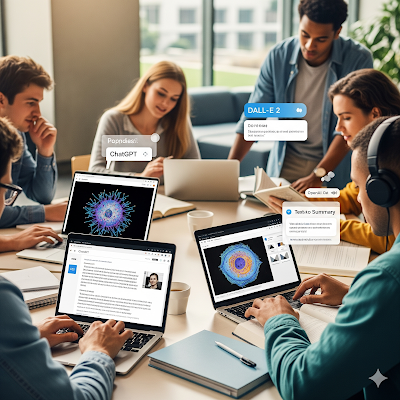Study Smart with OpenAI Tools ChatGPT, DALL.E, SORA and many more: A Student Guide
Comparison of OpenAI Tools and Why They Matter for Students:
This comparative table provides a concise overview of OpenAI’s major products, their purpose, and their significance. It is designed as a quick reference for students who need structured information at a glance.
| Tool / Model | Type / Category | Release Year | Key Feature / Purpose | Why Students Care |
|---|---|---|---|---|
| GPT-1 | Language Model | 2018 | Learned from 7,000+ books; 117M parameters | First step toward AI writing like humans; historical foundation for research. |
| GPT-2 | Language Model | 2019 | 1.5B parameters; powerful text generation | Sparked debates on AI misuse; shows early AI writing potential. |
| GPT-3 | Language Model | 2020 | 175B parameters; multitasking (poems, code, logic) | Useful for writing, coding, and logical reasoning exercises. |
| GPT-4 | Multimodal Model | 2023 | Handles text, images, and audio with system prompts | Great for assignments, reports, and mixed media projects. |
| GPT-5 (expected) | Advanced Model | 2025 (rumored) | Long-term memory, workflow integration | Could help manage research projects and long-term study notes. |
| ChatGPT | Chatbot (Text AI) | 2022 | Conversational AI with context understanding | Helps answer academic questions, brainstorm, and solve problems. |
| ChatGPT Deep Research | Research Chatbot | 2024–2025 | Layered explanations, web search + citations | Ideal for academic research, essays, and sourcing references. |
| GPTBot | Data Collector Bot | 2023 | Crawls websites for training GPT models | Indirect importance—students learn about AI ethics & data sourcing. |
| DALL·E (1–3) | Image Generator | 2021 | Text-to-image using CLIP | Students can make diagrams, posters, or creative presentations. |
| OpenAI Codex | Code Generator | 2021 (public in 2025) | Converts natural language into code; 12+ languages | Assists in learning programming, debugging, and coding homework. |
| OpenAI Five | Game AI (DOTA 2) | 2019 | Learned team strategy; beat world champions | Shows AI’s power in decision-making—case study in teamwork and logic. |
| Sora | Text-to-Video Generator | 2024 (tests) | Creates realistic videos from text prompts | Students in media/film can visualize concepts without cameras. |
| Whisper | Speech-to-Text | 2022 | Accurate multilingual transcription | Converts lectures/interviews into notes, even with noise. |
| OpenAI Gym | Reinforcement Learning Platform | 2016 | Train AI through trial-and-error games | Useful for computer science students studying machine learning. |
These comparisons make it clear that while each OpenAI product has a unique role, together they form a complete ecosystem—covering text, images, audio, video, coding, and even gaming. For students, this means a single platform to explore almost every frontier of artificial intelligence.
Related: Strange OpenAI Phenomenon
Now that we’ve seen how OpenAI’s products stand side by side, let’s begin with the most well-known one — ChatGPT.
ChatGPT: OpenAI’s Flagship AI Chatbot
It is the most notable and widely used product of OpenAI. Officially, it is Chat Generative Pre-Trained Transformer (ChatGPT) which means it generates answers with the data it has been trained and in a mood that suits your question.
Let’s Elaborate It:
-
Generative → It generates answers to the questions.
-
Pre-Trained → It has a lot of data fed into its system.
-
Transformer → It transforms its answers into every language and tone as per your questions.
What ChatGPT Does
It is an AI chatbot designed for text-based conversations, generating ideas and understanding daily-life problems. It is trained and fed with tons of data for the following reasons:
-
Grasping human questions.
-
Understanding the context.
-
Replying in the most efficient way possible.
This is the basic introduction to how ChatGPT works. Let’s move on to an interesting topic.
Has ChatGPT Passed the Turing Test?
The Turing Test is performed on machines to check whether their answers can confuse humans into thinking they are interacting with another human rather than a machine.
What We Know
-
According to stats online and some unofficial lab experiments, at least 50% of the people were confused by ChatGPT’s answers.
-
Some even wrote things like: “Are you even human? The amount of empathy you possess is insane.”
This confirms that if people are confused, the theory of Alan Turing has been successful somehow.
Official Position
OpenAI has not confirmed that ChatGPT passed the test. This is intentional to:
-
Maintain transparency and trust in AI.
-
Avoid marketing their AI tools as human equivalents.
-
Keep the focus on being confident in usefulness, not replacing humans.
ChatGPT Deep Research: Academic-Level Insights
If you are a student, researcher, writer, journalist, or blogger, you may need layered data on various topics. Layered data means explanations that go deeper within an explanation. That’s what ChatGPT Deep Research is built for.
Unique Features
-
Provides layered data (explanation within an explanation).
-
Cites references directly from trusted web sources.
-
Can search the web and fetch direct results, not just rely on pre-fed data.
Why ChatGPT Deep Research?
- Goes beyond the limits of normal ChatGPT.
- ChatGPT covers topics horizontally, while Deep Research is made for vertical learning.
- Offers deep insights on topics, useful for research or trend analysis.
-
Made for the actual assistance of actual learners.
How to Use ChatGPT Deep Research:
-
Upgrade to ChatGPT Pro or Plus plan.
-
Use the GPT-4o model to access tools like Web and Python.
-
From the model selector, choose “Deep Research” and start exploring.
Related: GPT 5 Secrets No One has Talked About
Other GPT Models
GPT-1: The Beginning of Generative Transformers
-
Released: 2018
-
Goal: Test if AI could write like humans by only reading text.
-
Key Features: Trained on 7,000+ books; 117M parameters.
-
Why It Mattered: Served as the foundation for later GPT models.
GPT-2: The Model Too Powerful to Release
-
Released: 2019
-
Goal: Large-scale text generation with minimal errors.
-
Key Features: 1.5B parameters; strong writing ability.
-
Why It Mattered: Its release was initially delayed due to concerns of misuse, which highlighted the ethical risks of AI.
GPT-3: The Multi-Tasking Performer
-
Released: 2020
-
Goal: Extend beyond simple text into poems, coding, and logic.
-
Key Features: 175B parameters; trained on diverse data including GitHub and Stack Overflow.
-
Why It Mattered: Proved GPT models could perform multiple tasks, making it a turning point in AI research.
GPT-4: The Multi-Modal Breakthrough
-
Released: 2023
-
Goal: Enable AI to process text, images, and audio together.
-
Key Features: Uses “system prompts” to guide behavior. Exact parameter count has not been disclosed by OpenAI, but industry estimates suggest 500B–1T parameters.
-
Why It Mattered: Marked a leap in multi-modal learning, useful for assignments, reports, and creative media.
GPT-5: The Next Leap in AI Evolution
-
Expected Release: 2025 (based on livestream announcements and industry reporting; no official confirmation from OpenAI at the time of writing).
-
Goal: Improve long-term memory and integrate tasks into seamless workflows.
-
Key Features: Official details are not released; rumors suggest enhanced memory and project management capabilities.
-
Why It Matters: If realized, it could serve as a comprehensive academic and research assistant.
GPTBot: The Data Collector Behind GPTs
It is developed by OpenAI but is not intelligent. GPTBot is basically a data collector for training GPT models. It crawls the web and goes through pages, checks what the page is about and collects the data.
It doesn’t analyze the data, just collects.
Sites can choose whether to allow or reject GPTBot. Many big websites like New York Times have banned their data to be used for training AI models.
DALL·E — AI That Paint Your Words:
DALL·E is OpenAI’s image generation model. While GPT models process and respond in text, DALL·E creates images from written prompts, combining creativity with logic.
How It Learns and Creates:
It uses Contrastive Language–Image Pre-training (CLIP) to connect words with pictures. Trained on millions of captioned images from the internet, it can generate realistic or imaginative visuals. OpenAI has not disclosed exact datasets due to copyright and licensing concerns. For instance, if a student types “a science lab floating in space,” DALL·E can generate a matching image.
Versions
-
DALL·E (2021): First experimental release.
-
DALL·E 2 (2022): Sharper, more realistic results.
-
DALL·E 3 (2023): Advanced version integrated with ChatGPT; more accurate with prompts and applies safety filters to avoid restricted content.
Why the Name?
The name combines the surrealist artist Salvador Dalí with the robot character WALL·E.
Why It Matters for Students
DALL·E helps students create diagrams, posters, infographics, and creative presentations, making it especially valuable in art, design, and media studies.
OpenAI Codex: Natural Language to Code
Codex is an OpenAI model designed for programming. It can read plain English instructions and translate them into code, making it a bridge between natural language and programming languages. It knows 12 programming languages.
How It Works
Codex is built on GPT-3 but trained specifically on large amounts of publicly available source code, including repositories from platforms like GitHub. This training allows it to understand both programming syntax and natural language. For example, if a student writes “make a calculator that adds two numbers,” Codex can generate the code instantly.
Versions
-
Codex (2021): First released through the OpenAI API.
-
Later versions were integrated into tools like GitHub Copilot, which helps programmers by suggesting real-time code completions.
Why It Matters for Students
Codex is especially valuable for computer science learners. It can:
-
Generate example code for assignments
-
Help debug errors
-
Provide step-by-step coding solutions
-
Support learning of multiple programming languages
OpenAI Five: Gaming AI That Beat Champions
It is an AI tool developed specifically to play DOTA 2. Valve released the multiplayer online battle arena video game DOTA 2 in 2013. The purpose was to build team coordination, strategic planning, and complex decision-making — all by using AI.
This tool is most near to mimicking emotions.
They aimed at making AI capable of taking complex decisions that involve retreating or being aggressive in “pressure” of gaming moments.
Guess what?
OpenAI Five succeeded in the mission.
Training:
Its training was crazy. The model trained itself by non-stop playing real games on a number of high-performance computers daily.
The experience it gained in one day was equivalent to the experience a human would gain in 180 years.
It also mimicked human instinct in gaming by displaying very calculated risky movements and pure logical movements.
Fun Fact:
It shook the world by defeating the DOTA 2 world champions “Team OG”.
It is the most fascinating AI tool to me. Though it is not available for public use because of its extreme hardware requirements and game-specific design, it is available for research and refining.
SORA: From Text to Video
It is a tool that converts your text to video without any camera. It generates constant image frames and displays them as a video.
The word “Sora” is originally Japanese meaning “sky.”
The aim was to make imagination reach the sky by converting any prompt into cinematic, clear, realistic and high-definition video.
Training:
Its training was difficult because you have to train AI like a cinematographer.
It had to learn to imagine scenes, maintain camera angles, expressions, and natural motion and consistent frames.
Along with this, logic and cause-effect were also taught to it.
Before launching, Hollywood filmmakers have tested it to ensure that it is useful for creative videography.
Whisper: Text to Speech with Accuracy
Whisper is OpenAI’s automatic speech recognition (ASR) system. It converts spoken language into written text and is designed to handle many accents, dialects, and background noises.
How It Works
Trained on around 680,000 hours of multilingual and multitask audio data collected from the web, Whisper is capable of transcribing, translating, and even detecting languages. For example, if a student records “Bonjour, je m’appelle Sara”, Whisper can both transcribe it in French and translate it into English as “Hello, my name is Sara.”
Why It Matters for Students
Whisper is useful in fields like linguistics, journalism, and education. Students can use it to:
-
Transcribe lectures or interviews
-
Translate foreign language materials
-
Generate subtitles for videos
OpenAI Gym: Training Ground for AI Models
It’s a gym developed for AI tools to exercise, lift weights, and get big and bulky like John Cena.
Nah. Just joking.
OpenAI Gym is a toolkit for developing and testing reinforcement learning (RL) algorithms. Instead of learning from text or images, reinforcement learning models improve by interacting with environments and receiving feedback in the form of rewards or penalties.
How It Works
Gym provides simulated environments — from simple tasks like balancing a pole on a cart to complex games such as Atari or robotic simulations. For example, a student can use Gym to train an agent to play Pong, where the model improves by playing repeatedly and adjusting strategies after each win or loss.
Why It Matters for Students
Gym is especially useful for those studying artificial intelligence, robotics, or computer science. It allows students to:
-
Experiment with RL concepts safely
-
Test algorithms in standardized environments
-
Understand how agents learn from trial and error
Final Comments:
OpenAI is more than just technology; it can do anything from deciphering your memes to whispering code, drawing dreams, and defeating grandmasters.
It’s your genius undercover.
Make good use of it…
Because a bot might be the source of your next idea.
Disclaimer and Sources:
-
References
This article has been prepared by studying multiple publicly available sources on artificial intelligence and OpenAI, including:
-
OpenAI’s official pages.
-
News and analysis from technology publications (MIT Technology Review, Wired, TechCrunch).
-
Educational articles and community discussions available online.
-
Note: The content is written in simplified, academic style for students and does not copy directly from any single source.
-















Thankyou so much for writing such an amazing content! So useful and informative